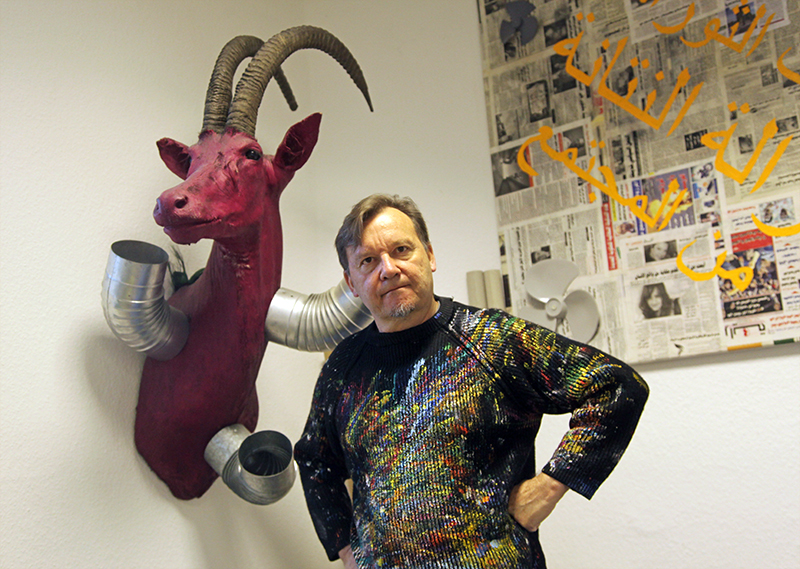Not A Government’s Prey

Goya painted the atrocities of the Peninsular War, Picasso’s production from 1937 to 1945 is known as “the war years” and Banksy is often criticizing the current system of Western governments. During the last month, protests took over the streets of many cities in Brazil. As artists are always reacting to social and political issues, I visited the studio of the Brazilian artist Alex Flemming (who kindly asked me to spell his last name correctly – not Flamingo and with a double 'm') to exchange some reflections about the current events, his artistic production and the combination of art and politics.
GALLERIES: FOR DOUBLE MEDIA BUZZ, CONSIDER A PARTNERSHIP WITH THE SWARM!
It’s been now twenty-two years since Flemming began living and working in Berlin. “The longest period I have ever spent in the same city” he recalls. Before finally settling, he lived in several places under very specific political conditions – such as East Berlin in the 80s and Sao Paulo during the Brazilian military government (also known as the right-wing military dictatorship, lasting from 1964 to 1985).
Acrylic On Protest
The frequent use of bright acrylic paint on vast canvases and unusual supports – such as furniture, clothes and even dead stuffed animals – can sometimes be distracting to the ideas behind the artwork, but he replies "I believe that the work of art has to have three things: color, form and concept.”
In the period of censorship in Brazil, he dared to create an exhibition of engravings about torture, one of his most obscure series. "I made a point of exhibiting it in 1978, the same year I produced it. I am very proud of that,” he recalls, “the same way I insisted on going to Tunisia and visiting the whole country to make the series about the revolution. I don’t want to do a series on the Arab revolution after ten years it happened. Never. I am a witness of my time.”
"Sumaré Station – Sao Paulo, Brazil" by Natasha No
As a Brazilian born in Sao Paulo, I got to know Flemming’s work pretty much like everyone else in the city. Built in the 90s, his most famous piece “Sumaré” is a public art installation on a subway station, seen by millions of people everyday.
Twenty Cents Too Much
These are the same millions of public transport users who did not abide by the government’s decision to raise the fares. In Sao Paulo, the biggest and most populated city in the country (almost twice the size of Berlin), the prices went from R$3,00 to R$3,20 (around 1,10 Euro). The protests started as a response to these high prices, since the transportation system is already in poor conditions – the buses and subways are constantly crowded and the current lines do not reach most of the areas (as you can see here).
The demonstrations have reached an unexpected proportion in social media where opinions, images and videos quickly spread in real time. "No doubt I was surprised, but I was pleasantly surprised because I think it's great for the people to finally try to grab the reins of their own country and to not be overwhelmed and guided by both the parties and corrupt politicians – be them from the right or left wing.”
The biggest target on the Internet was the police’s violent reaction against the protesters – attacking them with tear gas bombs, rubber bullets, pepper spray and arresting those who were caught carrying vinegar (yes, the salad topping is used to ease the effects from the teargas). At first, the protesters were generalized as medium-class rioters and the few acts of vandalism were emphasized. Curiously, after some journalists got injured while covering the facts, the press’ focus changed.
The manifestations became stronger as the population started to go to the streets under the “no violence” and “the giant woke up” mottos. Suddenly, it wasn’t about twenty cents anymore – it was the last drop for a nation who is almost 10% illiterate, suffering with the lack of a decent health system, occupying the 85th position in the Human Development Index and, outrageously, spending around 10 billion Euros for FIFA’s 2014 World Cup.
Censorship, media manipulation and years of unsolved issues by a government – what relation needs to be held between arts and politics? What part should an artist take in the middle of this chaos? “I think there are many types of art that are not political and are completely valid,” says Flemming. The artwork’s potential on contextualizing our contemporaneity has to be taken into account as "the artist has a public role: to see the reality, try to decipher it and return it as a discussion to the public. An artist has to reflect his own time.” And the time to reflect, according to Flemming, is always now.
Article by Bel Borst
Be the first to write a comment.
Your feedback



